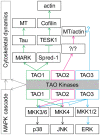Clinical and Neurobiological Aspects of TAO Kinase Family in Neurodevelopmental Disorders
- PMID: 33867937
- PMCID: PMC8044823
- DOI: 10.3389/fnmol.2021.655037
Clinical and Neurobiological Aspects of TAO Kinase Family in Neurodevelopmental Disorders
Abstract
Despite the complexity of neurodevelopmental disorders (NDDs), from their genotype to phenotype, in the last few decades substantial progress has been made in understanding their pathophysiology. Recent accumulating evidence shows the relevance of genetic variants in thousand and one (TAO) kinases as major contributors to several NDDs. Although it is well-known that TAO kinases are a highly conserved family of STE20 kinase and play important roles in multiple biological processes, the emerging roles of TAO kinases in neurodevelopment and NDDs have yet to be intensively discussed. In this review article, we summarize the potential roles of the TAO kinases based on structural and biochemical analyses, present the genetic data from clinical investigations, and assess the mechanistic link between the mutations of TAO kinases, neuropathology, and behavioral impairment in NDDs. We then offer potential perspectives from basic research to clinical therapies, which may contribute to fully understanding how TAO kinases are involved in NDDs.
Keywords: TAO kinase; cytoskeleton; de novo mutations; neurodevelopmental disorders; neuron; therapy.
Copyright © 2021 Hu, Feng, Yang and Xiao.
Conflict of interest statement
The authors declare that the research was conducted in the absence of any commercial or financial relationships that could be construed as a potential conflict of interest.
Figures




Similar articles
-
De Novo Variants in TAOK1 Cause Neurodevelopmental Disorders.Am J Hum Genet. 2019 Jul 3;105(1):213-220. doi: 10.1016/j.ajhg.2019.05.005. Epub 2019 Jun 20. Am J Hum Genet. 2019. PMID: 31230721 Free PMC article.
-
Neuroligins in neurodevelopmental conditions: how mouse models of de novo mutations can help us link synaptic function to social behavior.Neuronal Signal. 2022 May 10;6(2):NS20210030. doi: 10.1042/NS20210030. eCollection 2022 Jun. Neuronal Signal. 2022. PMID: 35601025 Free PMC article.
-
The molecular basis of p21-activated kinase-associated neurodevelopmental disorders: From genotype to phenotype.Front Neurosci. 2023 Mar 2;17:1123784. doi: 10.3389/fnins.2023.1123784. eCollection 2023. Front Neurosci. 2023. PMID: 36937657 Free PMC article. Review.
-
Improving treatment of neurodevelopmental disorders: recommendations based on preclinical studies.Expert Opin Drug Discov. 2016;11(1):11-25. doi: 10.1517/17460441.2016.1115834. Epub 2015 Dec 2. Expert Opin Drug Discov. 2016. PMID: 26558752 Review.
-
Reversibility and therapeutic development for neurodevelopmental disorders, insights from genetic animal models.Adv Drug Deliv Rev. 2022 Dec;191:114562. doi: 10.1016/j.addr.2022.114562. Epub 2022 Sep 29. Adv Drug Deliv Rev. 2022. PMID: 36183904 Review.
Cited by
-
Proteomic Identification of Phosphorylation-Dependent Septin 7 Interactors that Drive Dendritic Spine Formation.Front Cell Dev Biol. 2022 May 4;10:836746. doi: 10.3389/fcell.2022.836746. eCollection 2022. Front Cell Dev Biol. 2022. PMID: 35602601 Free PMC article.
-
Gene expression analysis of the Tao kinase family of Ste20p-like map kinase kinase kinases during early embryonic development in Xenopus laevis.Gene Expr Patterns. 2023 Jun;48:119318. doi: 10.1016/j.gep.2023.119318. Epub 2023 Apr 1. Gene Expr Patterns. 2023. PMID: 37011704 Free PMC article.
-
Alteration of the Early Development Environment by Maternal Diet and the Occurrence of Autistic-like Phenotypes in Rat Offspring.Int J Mol Sci. 2021 Sep 7;22(18):9662. doi: 10.3390/ijms22189662. Int J Mol Sci. 2021. PMID: 34575826 Free PMC article.
-
Genome Sequencing Identifies 13 Novel Candidate Risk Genes for Autism Spectrum Disorder in a Qatari Cohort.Int J Mol Sci. 2024 Oct 27;25(21):11551. doi: 10.3390/ijms252111551. Int J Mol Sci. 2024. PMID: 39519104 Free PMC article.
-
Paternal De Novo Variant of TAOK1 in a Fetus With Structural Brain Abnormalities.Front Genet. 2022 Jul 19;13:836853. doi: 10.3389/fgene.2022.836853. eCollection 2022. Front Genet. 2022. PMID: 35928450 Free PMC article.
References
LinkOut - more resources
Full Text Sources
Other Literature Sources

